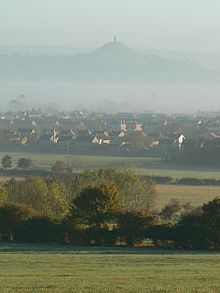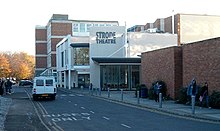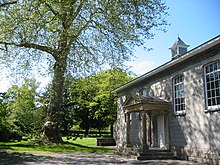Street, Somerset
| Street | |
|---|---|
Avon and Somerset | |
| Fire | Devon and Somerset |
| Ambulance | South Western |
| UK Parliament | |
Street is a large village and civil parish in Somerset, England, with a population of 11,805 in 2011.[1] On a dry spot in the Somerset Levels, at the end of the Polden Hills, it is two miles (three kilometres) southwest of Glastonbury. There is evidence of Roman occupation. Much of the history of the village is dominated by Glastonbury Abbey, and a 12th-century causeway from Glastonbury built to transport local Blue Lias stone to it.
The
The Clark family's former mansion and its estate at the edge of the village are now owned by
To the north of Street is the
History
The settlement's earliest known name is Lantokay, meaning the sacred enclosure of
The centre of Street is where Lower Leigh hamlet was, and the road called Middle Leigh and the community called Overleigh are to the south of the village. In the 12th century, a causeway from Glastonbury was built to transport stone from what is now Street for rebuilding Glastonbury Abbey after a major fire in 1184.[2] The causeway is about 100 yards (90 m) north of a Roman road running north from Ilchester. It will be seen that the name of the village predates the building of the causeway by more than four hundred years, and so the village is named after the Roman road and not the causeway.

The parish of Street was part of the
Quarries of the local
The churchyard of the Parish Church has yielded one Iron Age coin, however the origin and significance is unclear,
One biography of
Ivythorn Manor on Pages Hill was a medieval monastic house. It was rebuilt in 1488 for Abbot John Selwood of Glastonbury Abbey. After the Dissolution of the Monasteries it became a manor house owned by the Marshall and Sydenham families. Sir John Sydenham added a wing 1578 which was later demolished. By 1834 the house was largely ruined until its restoration around 1904, and a west wing was added in 1938. It is a Grade II* listed building.[12]
Governance
The
The total population equates to that shown above.
Street is in the
Street is
Geography

The
Before the 13th century, the direct route to the sea at Highbridge was blocked by gravel banks and peat near Westhay.
The

Merriman Park is named after
Climate
Along with the rest of
C. and J. Clark Ltd

The
The Clark family mansion and its estate at the edge of the village are now owned by
Transport
In Roman times Street was close to the route of the Fosse Way and is now on the route of the modern A39 road which runs from Bath to Cornwall, and the A361.
A number of bus services serve Street including route 376 to Bristol via Wells which is operated by First West of England and runs every 20 minutes Mon-Sat. It is also served by Berrys Coaches daily 'Superfast' service to and from London.[36]
Education


Primary infant/junior schools include Avalon, Brookside, Hindhayes, and Elmhurst.
At the edge of village is
Sport and leisure
Street has a Non-League football club Street F.C. who play at The Tannery.

Street has two public swimming pools, one indoor and one outdoor. The indoor pool forms part of the Strode complex. The outdoor pool, Greenbank, is open daily from early May until mid September each year.[41]
The only single use cinema in Street was closed down and converted into a nightclub in the 1990s. Strode Theatre, linked to the Crispin School and Strode College complex, is now the only place to see films, exhibitions and live performances.[42] It opened on 5 October 1963 with a performance by the Bournemouth Symphony Orchestra.[43] In 1999 the theatre was expanded with a new foyer, bar and box office along with improved rehearsal space and stage access, at a cost of £750,000 by the Steel, Coleman Davis partnership who received an award for the design.[44] The expansion was funded by the Arts Council England.[45]
The village is on the route of the Samaritans Way South West.
Religious sites

The Anglican Parish
Notable people
- Helen Chamberlain, an English television presenter, was born in Street in 1967.[52]
- Alice Clark, historian and suffragist, author of Working Life of Women, was born and died in Street.
- Edwin Edwards (organist), organist, composer, Director of Music at Rugby School, was born in Street in 1830.[53]
- John Hinde was born in Street before going on to become a photographer whose idealistic and nostalgic style influenced the art of postcard photography and was widely known for his meticulously planned shoots.[54]
- Clemence Housman, an author, illustrator and suffragette, lived with her brother Laurence in Street.
- A.E. Housman.[55]
- Catherine Impey, the founder, editor, and publisher of an antirace journal Anti-Caste (1888–1895) was born in Street in 1847. Catherine rejected race, caste, and gender violence. She was friends with Frederick Douglass, Ida B. Wells and other African Americans with whom she continued a global movement against racism, casteism, and gender problems. She died in 1923.[56]
- Jaye Jacobs, actress[57]
- John X. Merriman was born in Street in 1841, His parents were Nathaniel James Merriman, curate of the parish of Street and later third Bishop of Grahamstown, and the former Julia Potter. He emigrated to the Cape Colony with his parents in 1849, aged 8. He was the last prime minister of the Cape Colony before the formation of the Union of South Africa in 1910.[25][58]
- Henry John "Harry" Patch (1898-2009), the last surviving 'Tommy' from the First World War, moved to Street in the early 1940s, and ran a plumbing company in the village until his retirement at age 65.[59]
Freedom of the Parish
The following people and military units have received the Freedom of the Parish of Street.
References
- ^ a b "Street Parish (2011)". Neighbourhood Statistics. Office for National Statistics. Archived from the original on 2 January 2014. Retrieved 1 January 2014.
- ^ a b c d Gathercole, Clare. "Street" (PDF). Somerset Urban Archaeological Survey. Somerset County Council. Archived from the original (PDF) on 17 July 2011. Retrieved 21 August 2009.
- ^ Eilert Ekwall, The Concise Oxford Dictionary of English Place-names, p.450.
- ^ "Somerset Hundreds". GENUKI. Retrieved 22 October 2011.
- ^ Ambrose, K.; 2001: The lithostratigraphy of the Blue Lias Formation (Late Rhaetian–Early Sinemurian) in the southern part of the English Midlands, Proceedings of the Geologists' Association 112(2), pp. 97–110.
- ^ "The History behind the ichthyosaur logo". Street Parish Council. Archived from the original on 8 October 2011 – via Internet Archive.
- ^ "Palaeontological Association Review Seminar" (PDF). The Palaeontological Association. Retrieved 21 August 2009.
- ^ "Iron Age Coins". Cardiff University. Retrieved 2 September 2010.
- ^ a b "The archaeology of Street Churchyard". Holy Trinity Street and Walton. Archived from the original on 14 August 2007. Retrieved 21 August 2009.
- ^ "Llan". Place names. BBC Wales. Retrieved 2 September 2010.
- ^ Historic England. "Abbots Sharpham and Sharpham Park Farmhouse (1345069)". National Heritage List for England. Retrieved 25 November 2006.
- ^ Historic England. "Ivythorn Manor (1176171)". National Heritage List for England. Retrieved 3 July 2010.
- ^ "Street UD". A vision of Britain Through Time. University of Portsmouth. Retrieved 4 January 2014.
- ^ "Your Councillors". Mendip District Council. Archived from the original on 4 March 2011. Retrieved 2 September 2010.
- ^ "Wells". 2010 General Election Results. BBC. Retrieved 2 September 2010.
- ^ "Twin Towns". Teignmouth Twinning Association. Archived from the original on 20 February 2012. Retrieved 7 October 2012.
- ^ "British and French Twin Towns". France Magazine. Retrieved 22 August 2010.
- ^ "Pomparles Bridge". ArthurianAdventure.com. Archived from the original on 17 October 2008. Retrieved 11 November 2008.
- ^ "Pomparles Bridge, Northover, Glastonbury". Somerset Historic Environment Record. Somerset County Council. Retrieved 4 July 2010.
- ^ "Meare and Ferran Mere". Sacred Sites around Glastonbury. Archived from the original on 2 August 2012. Retrieved 1 November 2008.
- ^ "Brue Valley Living Landscape". Somerset Wildlife Trust. Archived from the original on 5 June 2011. Retrieved 2 July 2010.
- ^ "Walton and Ivythorn Hills" (PDF). English Nature. Retrieved 21 August 2006.
- ^ "East Polden Grasslands" (PDF). English Nature. Retrieved 12 August 2006.
- ^ "Street Heath" (PDF). English Nature. Retrieved 21 August 2006.
- ^ a b "The Merriman Family" (Word). Street Society. Retrieved 7 June 2012.
- ^ a b c d "South West England: climate". Met Office. Archived from the original on 5 June 2011. Retrieved 14 March 2010.
- ISBN 1-902007-01-8.
- ^ Historic England. "Main roadside frontage to Clarks Factory, Clock Tower, 5 bay right return and Water Tower (1058755)". National Heritage List for England. Retrieved 23 March 2008.
- ^ "Street". Visit Somerset. Archived from the original on 5 May 2013. Retrieved 6 June 2012.
- ^ "Shoe Museum". Information Britain. Retrieved 12 July 2009.
- ^ "The Shoe Museum, Street". Nothing to see here. Retrieved 12 July 2009.
- ^ "The Shoe Museum". Somerset Tourist Guide. Archived from the original on 9 May 2008. Retrieved 12 July 2009.
- ^ "Youth Hostel, Street". Youth Hostel Association. Retrieved 2 July 2010.
- ^ "Glastonbury". Somerset and Dorset Joint Railway. Archived from the original on 6 May 2011. Retrieved 3 July 2010.
- ^ Nevard, Chris. "Glastonbury after closure". Archived from the original on 16 December 2009. Retrieved 3 July 2010.
- ^ https://book.berryscoaches.co.uk/superfast-timetables.html Superfast Timetable
- ^ "Crispin School". Ofsted. Archived from the original on 16 February 2011. Retrieved 1 April 2009.
- ^ "University Level courses" (PDF). Strode College. Archived from the original (PDF) on 28 November 2009. Retrieved 5 July 2009.
- ^ "Millfield School". Millfield School. Retrieved 2 July 2010.
- ^ "Millfield in its Infancy" (Word). Street Society. Retrieved 7 June 2012.
- ^ "Greenbank Pool". Greenbank Pool. Retrieved 21 August 2009.
- ^ "Strode Theatre". Strode Theatre. Retrieved 21 August 2009.
- ^ "Strode Theatre". Total Travel.com. Archived from the original on 31 January 2010. Retrieved 4 July 2010.
- ^ "Strode Theatre". Steel Coleman Davis Partnership. Retrieved 16 September 2012.
- ^ "Strode Theatre". Bailey partnership. Retrieved 16 September 2012.
- ^ Historic England. "Church of The Holy Trinity (1058753)". National Heritage List for England. Retrieved 23 March 2008.
- ^ "History". Holy Trinity Street and Walton. Retrieved 17 May 2009.
- ^ "Our Churches". Hily Trinity Street and Walton. Archived from the original on 20 July 2010. Retrieved 2 September 2010.
- ^ "Street Baptist Church". Street Baptist Church. Retrieved 2 September 2010.
- ^ Historic England. "Friends Meeting House (1308052)". National Heritage List for England. Retrieved 23 March 2008.
- ^ "Parishes: Street | British History Online". British-history.ac.uk. Retrieved 12 January 2020.
- ^ "Helen Chamberlain". IMDb. Retrieved 3 July 2010.
- ISBN 9780720123302.
- ^ Sarsby, Jacqueline (3 February 1998). "Obituaries: John Hinde". The Independent. Archived from the original on 25 May 2022. Retrieved 3 July 2010.
- ^ "Catalogue of Laurence Housman's works". Street Society. Archived from the original (Word) on 13 August 2014. Retrieved 7 June 2012.
- ^ "Catherine Impey of Street, Somerset, and her radical anti-racist newspaper". Quaker Strong Rooms. 18 September 2012. Retrieved 21 September 2016.
- ^ "Jaye Jacobs". Holby.tv. Archived from the original on 25 May 2010. Retrieved 3 July 2010.
- ^ Cana, Frank Richardson (1922). . Encyclopædia Britannica. Vol. 31 (12th ed.). p. 914.
- ^ "Obituary: Private Harry Patch". The Daily Telegraph. London. 25 July 2009. Retrieved 25 July 2009.
- ^ "Courageous Royal Marine Matt Tomlinson honoured by his community | Just Plymouth".
External links
- Street at Curlie

